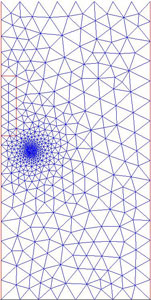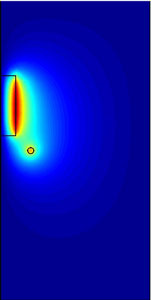|
|||||
Efficient Algorithms for Inverse Magnetic Field Problemsby Domenico Lahaye The design of electromagnetic devices can be stated in mathematical terms as inverse magnetic field problems. Solving these hard optimisation problems efficiently is of prime industrial relevance. At CWI, research has started on a new class of algorithms for inverse problems based on the space-mapping algorithm. This algorithm exploits a multiscale representation of the space of design variables, in order to speed up the convergence of the optimisation process. Applications include the design of low-frequency electromagnetic energy transducers. In recent decades, the use of mathematical modelling and numerical techniques in the industrial design of electrical machines and transformers has gained popularity. Mathematical models for electromagnetic energy transducers are built starting from the Maxwell equations - a set of coupled partial differential equations describing electric and magnetic fields. These equations are treated numerically by discretising them, for example, by the finite element method. In industrial design practice, so-called inverse magnetic field problems arise frequently. These are optimisation problems in which one seeks a source distribution that produces an a priori specified magnetic field. These hard, nonlinear optimisation problems are mathematically intriguing due to their ill-posedness and non-unique solutions. Furthermore, finding solutions efficiently is critical, and is a key ingredient in the design of high-gain electromagnetic energy transducers that are less susceptible to undesirable parasitic effects such as heat, noise and mechanical vibrations. These inverse magnetic problems include design variables such as descriptions of the geometry of a device (eg the width of the air gap in an electrical machine), and external loading conditions in terms of applied currents and voltages (eg the current through the coils in an MRI scanning instrument). The evaluation of the function to be minimised (the cost function) for given values of the design variables requires a finite element simulation. These simulations form a computational bottleneck, especially in performing full three-dimensional or transient modelling. Recently, the MAS2 research group at CWI started a research project with the aim of improving existing solution techniques for inverse magnetic field problems. The goal of this research project is to construct and apply new optimisation algorithms that reduce the required number of cost function evaluations. These algorithms are based on a recently introduced idea known as 'space mapping'. Space-mapping algorithms exploit a multiscale representation of the search space in order to accelerate the convergence of the iterative optimisation process. While fine-scale models correspond to the previously mentioned finite element models, coarse-scale models are simple analytic models for the device under consideration. Examples include magnetic equivalent circuits (equivalent to electrical circuits) or analytical expressions for the electromagnetic force and torque (such as the Biot-Savart law). The coarse-scale representation allows well-established rules of thumb to be incorporated in the optimisation process. The mapping from fine to coarse space is performed through a parameter extraction process. The space-mapping technique was introduced in the context of microwave engineering.
In our project, we must solve quasi-stationary inverse magnetic field problems. The aims of the project are twofold. Firstly, we want to provide a theoretical framework for the space-mapping technique in order to gain insight into its convergence properties. We will do so by establishing links between the space-mapping technique and seemingly closely related defect correction techniques. For the latter, a sound mathematical theory exists. Secondly, we want to apply the space-mapping technique for the solution of quasi-stationary inverse magnetic field problems. A typical application that we have in mind is the design of a linear actuator to be used in a high-accuracy positioning system. This research effort is a collaboration between the MAS2 research group and the Electromechanics and Power Electronics (EPE) research group at the Eindhoven University of Technology, who will provide their expertise in modelling and design of electromagnetic devices and in the validation of design through experiments. The Dutch Ministry of Economic Affairs is funding the project through an intensive research program in electromagnetic power conversion technology (IOP-EMVT). We envisage two possible extensions of the current project. In the first of these, we plan to apply the space technique in the design of contactless energy transfer systems. In these systems, electrical energy is transmitted by magnetic induction, and electrical connections and physical contact are avoided. Recent applications of CETS have emerged, for example, in the transfer of energy to mobile platforms, in the intervention-free charging of household appliances and in medical scanning systems. In the second project extension, we plan to solve inverse problems in which magnetic and thermal aspcets are coupled. Solving these problems is an important step in the design of electromagnetic energy transformers that minimise heat loss. Link: Please contact: |
|||||




